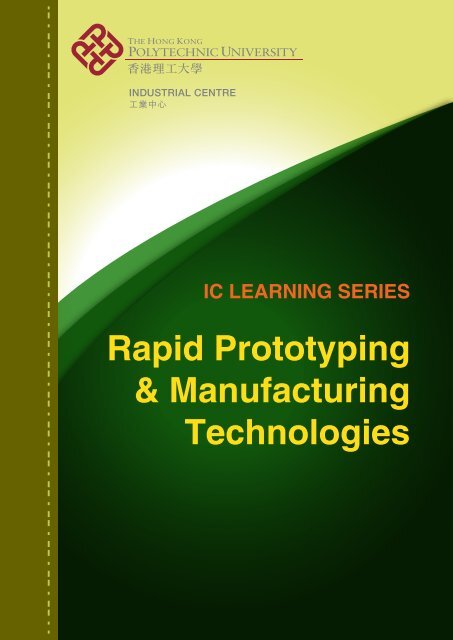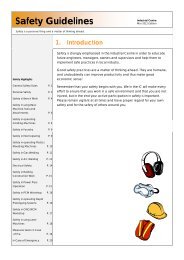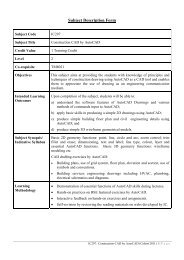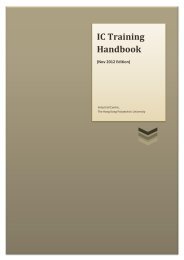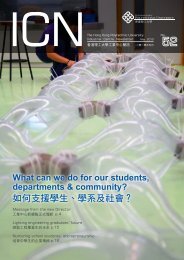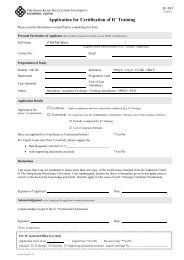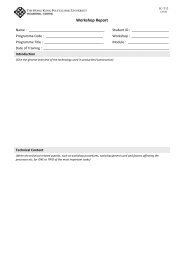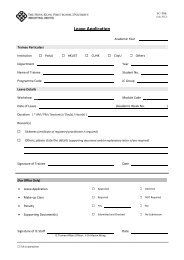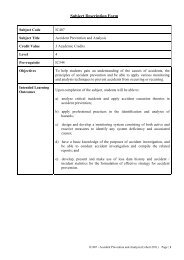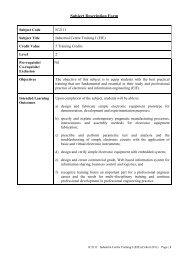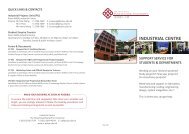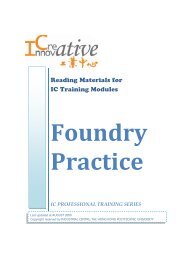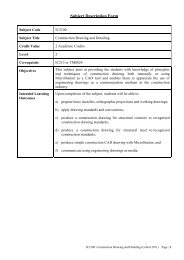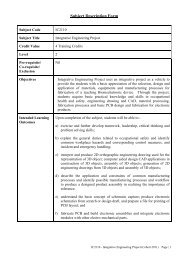Rapid Prototyping & Manufacturing Technologies - to submit your ...
Rapid Prototyping & Manufacturing Technologies - to submit your ...
Rapid Prototyping & Manufacturing Technologies - to submit your ...
Create successful ePaper yourself
Turn your PDF publications into a flip-book with our unique Google optimized e-Paper software.
<strong>Rapid</strong> <strong>Pro<strong>to</strong>typing</strong> & <strong>Manufacturing</strong> <strong>Technologies</strong><strong>Rapid</strong> <strong>Pro<strong>to</strong>typing</strong> &<strong>Manufacturing</strong><strong>Technologies</strong>Objectives:To understand the importance and applications of rapid pro<strong>to</strong>typing andmanufacturing (RP&M) technologies in the product design anddevelopment processes.To understand the general function of pro<strong>to</strong>type in the product design anddevelopment process.To appreciate the common types of rapid pro<strong>to</strong>typing systems.To understand the basic steps in RP process.To learn the basic of <strong>Rapid</strong> Tooling process.1. IntroductionIn recent years, opening up local markets for worldwide competition has led <strong>to</strong> afundamental change in new product development (NPD). In order <strong>to</strong> staycompetitive, manufacturers should be able <strong>to</strong> attain and sustain themselves as"World Class Manufacturers". The manufacturers should be capable in deliveringproducts in fulfilling the <strong>to</strong>tal satisfaction of cus<strong>to</strong>mers, products in higher quality,short delivery time, at reasonable costs, environmental concern and fulfill all thesafety requirements.In many fields, there is great uncertainty as <strong>to</strong> whether a new design will actuallydo what is desired. New designs often have unexpected problems. A pro<strong>to</strong>type isoften used as part of the product design process <strong>to</strong> allow engineers and designersthe ability <strong>to</strong> explore design alternatives, test theories and confirm performanceprior <strong>to</strong> starting production of a new product. Engineers use their experience <strong>to</strong>tailor the pro<strong>to</strong>type according <strong>to</strong> the specific unknowns still present in theintended design.<strong>Rapid</strong> <strong>Pro<strong>to</strong>typing</strong> technology employ various engineering, computer control andsoftware techniques including laser, optical scanning, pho<strong>to</strong>sensitive polymers,material extrusion and deposition, powder metallurgy, computer control, etc. <strong>to</strong>directly produce a physical model layer by layer (Layer <strong>Manufacturing</strong>) inaccordance with the geometrical data derived from a 3D CAD model. RP candeliver working pro<strong>to</strong>type at the early design stage of the new product cycle. Somanufacturers can use the working pro<strong>to</strong>types in bridging a multi-disciplinedPage 1IC Professional Training
<strong>Rapid</strong> <strong>Pro<strong>to</strong>typing</strong> & <strong>Manufacturing</strong> <strong>Technologies</strong>team composed of the marketing, design, engineering and manufacturing people<strong>to</strong> design right at the first instance in catering for the cus<strong>to</strong>mers.<strong>Rapid</strong> pro<strong>to</strong>typing (RP) is rapid creation of a physical model. However, rapidpro<strong>to</strong>typing is slowly growing <strong>to</strong> include other areas. So, <strong>Rapid</strong> <strong>Pro<strong>to</strong>typing</strong>,Tooling and <strong>Manufacturing</strong> (RP&M) should be used <strong>to</strong> include the utilization ofthe pro<strong>to</strong>type as a master pattern for <strong>to</strong>oling and manufacturing.1.1 Types of pro<strong>to</strong>type for NPDBefore getting involves <strong>to</strong> the <strong>to</strong>pic of RP&M, the fundamental concepts andapplications of pro<strong>to</strong>types should be obtained. Pro<strong>to</strong>types that will be required inthe product design and development process are commonly divided in<strong>to</strong> thefollowing types.• 3D sketches• Cosmetic pro<strong>to</strong>types• Engineering / Functional pro<strong>to</strong>types• Samples for safety approval• Marketing Samples1.1.1 3D sketchesTraditionally product designer use foam, cardboard, clay or wood <strong>to</strong> make quickmodels. The designers may generate a lot of simple model a day <strong>to</strong> visualizedifferent ideas. They also interchange portions of different models by cut andpaste, or reshape the model <strong>to</strong> explore different possibility. Since it is the earlystage of the project, usually the models are not presented <strong>to</strong> outside clients,therefore colors and textures and surface finishing are not an issue.Among various RP technologies, Multi-jet Modeling (MJM) and 3D-printing (3DP)technologies is most suitable for 3D sketches not only because they are faster, butalso because they are less expensive and the models are easier <strong>to</strong> reshape.1.1.2 Cosmetic pro<strong>to</strong>typesAs the name implied, the pro<strong>to</strong>types are used <strong>to</strong> evaluate the appearance andfeeling of the design, and get early comments from potential clients. Apart fromsolid and non-functional, cosmetic pro<strong>to</strong>types are the same as finished product inaspect, such as shape, color, texture and hardness.Most RP technologies can be used for cosmetic pro<strong>to</strong>types. However, those withbetter post-processing properties will have a competitive edge because a lot ofpolishing and painting will be applied on the model. In this perspective, SLA &MJM are easier <strong>to</strong> polish because of its smooth surface. FDM is more difficultbecause the part have <strong>to</strong> be cover with a layer of putty. SLS and LOM are amongthe most difficult, due <strong>to</strong> the <strong>to</strong>ugh nylon material and fiber strands of paper.'Concept modelers' is the choice where time is the most critical concern. Theseinclude droplet deposition systems such as InVision, Objet and ZCorp's machine.Page 2IC Professional Training
1.1.3 Engineering / Functional pro<strong>to</strong>types<strong>Rapid</strong> <strong>Pro<strong>to</strong>typing</strong> & <strong>Manufacturing</strong> <strong>Technologies</strong>In engineering development, Engineers will evaluate the form, fit and function ofthe parts. The pro<strong>to</strong>type will use the same material of the final product iftechnology permitted. If exact material is not available, the materials with similarmechanical, thermal and electrical properties are used. The SLS and FDM allow theuse of production grade plastic material, although the mechanical properties arenot exactly the same.1.1.4 Samples for safety approvalFor those products that are regulated by safety standards of importing country, atlease 5-10 product samples have <strong>to</strong> be <strong>submit</strong>ted <strong>to</strong> the labora<strong>to</strong>ry for eachapplication. If pilot run of the product is ready, the finish products will be<strong>submit</strong>ted. However, in most case the project is still in <strong>to</strong>oling stage, and samplesby PU duplication may be used if the labora<strong>to</strong>ry accepts. 5 <strong>to</strong> 10 duplicates can beproduced in a day. PU duplicate cannot be used as substitution if the part underconsideration is subjected <strong>to</strong> high temperature, voltage and mechanical abuse. Inthis <strong>Rapid</strong> Tooling techniques can be used. Manufacturers have a choice <strong>to</strong> quicklybuild a mould and produce a small batch of sample parts in actual productionmaterial.1.1.5 Marketing SamplesAt a later stage when all design details are finalized and the project is in <strong>to</strong>olingstage, the marketing department will start the promotion campaign. A lot ofsamples may be distributed <strong>to</strong> clients. In this case, up <strong>to</strong> a hundred products maybe needed. Normally the samples will be made by RTV mould and PU duplicationtechnique. In many cases, these models are also used <strong>to</strong> take the picture thatappears in the package box or user manual.1.2 Differences between conventional machining and rapid pro<strong>to</strong>typingConventional machining can produce pro<strong>to</strong>types using metal removal methodwith almost any type of engineering materials however there are only a limitedtype of materials for any particular type of RP&M systems. RP&M systems areusually used for making one or a few sample of pro<strong>to</strong>type, while the number ofpro<strong>to</strong>type produced in conventional machining can be adjusted as required. Thebasic working principle of RP technologies is <strong>to</strong>tally different from conventionalmachining processes which build up a solid by mean of addition approach likeconstruction of the building. Hence the RP also started from foundation thengradually increase in height until it reached the <strong>to</strong>p layer.Page 3IC Professional Training
<strong>Rapid</strong> <strong>Pro<strong>to</strong>typing</strong> & <strong>Manufacturing</strong> <strong>Technologies</strong>Fig. 1.1 Differences between conventional machining and rapid pro<strong>to</strong>typing1.3 Why RP&MThe application of the RP&M in the NPD can resolves the Fuzzy Front End – themessy getting started period of NPD process - would be relatively costly andtimely. However using RP&M enable manufacturers <strong>to</strong> schedule the right productbeing developed in a timely manner is the most important winning strategy. Thecombination of the RP&M and CAD technologies in blending with traditionaltechnologies and gradually formation of cross-functional team are the strategiesfor survival or strategies for empowering organization, people and facilities.1.4 Limitations of RP&MHigh precision RP machines are still expensive at around US$ 100 thousands <strong>to</strong> 1million and not easy <strong>to</strong> justify economically and many service bureaus in providingthe physical pro<strong>to</strong>types output services. However, as the RP technologies aregetting more mature while RP manufacturers are facing more head-<strong>to</strong>-headcompetition, the price will go down significantly in the near future such as thelaunch of V Flash priced at US$ 10 thousands. Most of the budget RP systems aredifficult <strong>to</strong> build parts with accuracy under +/-0.02mm and wall thickness under0.5mm. This is sufficient for pro<strong>to</strong>types built for concept evaluation and functionaltest.However, pro<strong>to</strong>types that will be used as master pattern for downstreamprocesses always require a much higher and consistent accuracy. Although thereare quite a large variety of materials that can be used in most RP processes, thephysical properties of the RP parts are normally inferior <strong>to</strong> those samples thatmade in proper materials and by the traditional <strong>to</strong>oling. The RP parts are notcomparable <strong>to</strong> traditional Computer Numerical Control machined (CNC) pro<strong>to</strong>typeparts in the surface finishing, strength, elasticity, reflective index and othermaterial physical properties.Page 4IC Professional Training
1.5 The future market profile of RP&M systems<strong>Rapid</strong> <strong>Pro<strong>to</strong>typing</strong> & <strong>Manufacturing</strong> <strong>Technologies</strong>The future market profile of the rapid pro<strong>to</strong>typing/manufacturing industry willhave two specific niches. The first one will be focused on Digital Direct<strong>Manufacturing</strong> (DDM) of engineering parts for not only testing form fit, functionalevaluation, but also can be directly used in products. The second niche will belooking at the market requirement in another point of view. It will focus onconcept modeling or 3-Dimensional printing for design verification, preliminarymarketing <strong>to</strong>ol and manufacturability studies. In this case, the most importantconsiderations are speed and low cost. The accuracy and resolution requirement isminimal so far it can provide the designer a reasonable representation of thedesign.2. Common Types of <strong>Rapid</strong> <strong>Pro<strong>to</strong>typing</strong> <strong>Technologies</strong>While there are many ways in which one can classify the numerous RP systems inthe market, one of the better ways is <strong>to</strong> classify RP systems broadly by the initialform of its material, i.e. the material that the pro<strong>to</strong>type or part is built with. In thismanner, all RP systems can be easily categorized in<strong>to</strong> (1) liquid-based (2) solidbasedand (3) powder-based.Liquid-based RP systems have the initial form of its material in liquid state.Through a process commonly known as curing, the liquid is converted in<strong>to</strong> thesolid state. The Stereolithography Apparatus (SLA) falls in<strong>to</strong> this category.Solid-based RP systems encompass all forms of material in the solid state. In thiscontext, the solid form can include the shape in the form of wire, roll, laminates,pellets and powders. The Selective Laser Sintering (SLS), Three-DimensionalPrinting (3DP) Fused Deposition modeling (FDM) fall in<strong>to</strong> this definition.2.1 Stereolithography Apparatus (SLA) – Liquid based RPStereolithography Apparatus (SLA) technology fabricates three-dimensional, solidobjects resin using a computer-directed, ultraviolet (UV) laser beam <strong>to</strong> curesuccessive layers of pho<strong>to</strong>-sensitive polymer resin in a vat.SLA part is fabricated by laser spot instead of continues scanning on the resinwhich forms a thin solid layer on the surface of the liquid resin through thepho<strong>to</strong>polymerization. Figure 2.1 shows the schematic diagram of this spotscanning mechanism.Polymerization is the process of linking monomers and oligomers in<strong>to</strong> largermolecules (polymers). When pho<strong>to</strong>initia<strong>to</strong>rs in the SLA resin are energized by thelaser spot energy exposure (Ec value in mJ/cm2) will undergoes thepho<strong>to</strong>polymerization process. It creates a thin layer of solid resin with thicknessabout 2-3 times thicker than the layer thickness (overcure). The <strong>to</strong>tal thickness ofPage 5IC Professional Training
<strong>Rapid</strong> <strong>Pro<strong>to</strong>typing</strong> & <strong>Manufacturing</strong> <strong>Technologies</strong>control in ensuring the reaction conditions. For example, the chamber of SLA ismaintained at 28°C ± 1°C.Resins used in SLA process are mixture of pho<strong>to</strong>-initia<strong>to</strong>r, linkers, oligomers andmonomer mixture in liquid state, pho<strong>to</strong>nic energy source will trigger the chainreaction of polymerization. Two parameters penetration depth (Dp) and criticalexposure (Ec), which are vary from different resins, are as the primary input <strong>to</strong> theSLA machine for controlling the power and time of laser emission. The followingillustrate the underlying principle of the two important parameters;Penetration Depth (Dp) and Critical Exposure(Ec)When a beam of light hit the resin surface, it will cure a region of resin in theshape of a bullet. The intensity of the beam determined the extent of reaction andthe size of the bullet.The threshold exposure, Ec, is the energy required for the pho<strong>to</strong>polymer changesfrom the liquid <strong>to</strong> the gel phase. In the process, D p and E c is primary characters ofthe resin provided by manufacturer. The SLA machine determine P L and V s on thefry by the relation that the draw speed of the laser V s proportional <strong>to</strong> (P L /E C )exp(-C d /D p ).C pD pE maxE cCritical depth, given by the functionC d =D p ln(E max /E c )The depth of penetration which thepower of laser decay <strong>to</strong> approx. E max /3The power of laser at resin surfaceCritical Exposure, a primary resincharacter, unit in mJ/cm 2Page 8IC Professional Training
<strong>Rapid</strong> <strong>Pro<strong>to</strong>typing</strong> & <strong>Manufacturing</strong> <strong>Technologies</strong>2.1.3 Support StructureSupport usually need for liquid-based and solid-based RP systems in order <strong>to</strong> anchorthe part <strong>to</strong> the platform hence the part can be separated from the platform thuspreventing floating layers and make removal of the part became simple.Also support is needed for overhanging and tilted surfaces hence minimize part curland stabilize the part while being built. Self support angle is a predetermined anglefor the particular SLA RP system such that tilted surfaces with this angle from thehorizon needs no support.The supported surfaces are the overhanging down face of the part. Since supportsneed <strong>to</strong> anchor the surface at the contact point. Hence the surfaces in contact withthe support are rough and coated with resin gel after the part build completed. So donot place supports on surfaces where finish is important.PartPartProjectionStandFig. 2.4 SLA support structure, Left: curtain support. Right: fine-point supportSupport can be classified according <strong>to</strong> the support structure and the type of surfacesbeing supported. Support types include solid, box, web and fine point supports.Besides supports classified according <strong>to</strong> the geometry of the down face include point,line and surface supports.SLA uses Fine-point support style as the default support style, however when longand slender support is need then Curtain support style can be used <strong>to</strong> ensure thestrength of the support while the pro<strong>to</strong>types are build in the vat. Figure 2.4 showsboth SLA support styles.2.1.4 Building StylesThe rapid pro<strong>to</strong>typing systems usually bundled with software which can control the buildstyles, generate supports, slicing of the STL files and creating control file for buildingthe pro<strong>to</strong>type in the RP machine. There are Part build style, Support build style, PartRecoat style and the Support Recoat style in the SLA software called 3DLightyear.Part build style controls the laser when drawing the part. Different part build stylecan produce part in different patterns which include the solid part – the exact buildstyle, the hollow part for investment casting – Quickcast build style. The fast buildstyle which shortens the build time of the part by filling the part in alternate layers.Page 10IC Professional Training
<strong>Rapid</strong> <strong>Pro<strong>to</strong>typing</strong> & <strong>Manufacturing</strong> <strong>Technologies</strong>Support build styles control the laser when drawing the support. Curtain support orFine point support can be created by choosing different support build styles in SLAbuilding platform.Part recoat styles controls the recoating process including the dipping depth andspeed of the build platform and the speed and the number of recoats of the recoatblade.Support recoat styles controls the recoating process while building the support.2.2 Fused Deposition Modeling (FDM)2.2.1 Processes descriptionFused Deposition Modeling (FDM) was developed by Scott Crump, the founder ofStratasys. It was commercialized by Stratasys in 1991. FDM process create componentby extruding material (normally a thermoplastic material) through a nozzle thattraverses in X and Y <strong>to</strong> create each two-dimensional layer.Heaters which surround two separated nozzles keep the plastic at a temperature justabove its melting point so that it flows through the nozzle and forms the layeraccording <strong>to</strong> the <strong>to</strong>ol path. In each layer separate nozzles extrude and depositmaterial that forms the parts and the support structure. The plastic hardensimmediately after flowing from the nozzle and bonds <strong>to</strong> the layer below. Once a layeris built, the platform lowers, and the extrusion nozzle deposits another layer and theprocess is repeated until the object is completed. Figure 2.5 show a schematicdiagram of FDM process.Fig. 2.5 Schematic diagram of FDM processesPage 11IC Professional Training
<strong>Rapid</strong> <strong>Pro<strong>to</strong>typing</strong> & <strong>Manufacturing</strong> <strong>Technologies</strong>Support structure can be removed manually or, when water soluble supports areemployed, they can be simply dissolved by put in<strong>to</strong> particular chemical solution.However, soluble support is only available for building ABS model, other high meltingpoint plastic material such as polycarbonate (PC) and polysulphone (PPSF) are notapplicable.2.2.2 FDM materialThe build material is usually supplied in filament form with 1.8mm diameter, but thelayer thickness and vertical dimensional accuracy is determined by the extrusionnozzle diameter and the rate of feeding of the building material, which ranges from0.018 <strong>to</strong> 0.008 inches. In the X-Y plane, 0.001 inch resolution is achievable.Thermoplastic material is most often used which including Acrylonitrate ButadieneStyrene (ABS), Polycarbonate (PC), polysulphone (PPSF), and investment casting wax isdesigned for investment cast.ABSi ABS-M30* PC-ABS PC* ULTEM9085PPSF*Appearance Ivory White TanTensile Strength(MPa)Tensile Modulus(MPa)FlexuralStrength (MPa)FlexuralModulus (MPa)Notched IzodImpact (J/m)Heat deflection( o C)38 36 34.8 52 72 551993 2413 1827 2000 2220 206859 61 50 97 115 1101797 2317 1863 2137 2507 2206139 123 53.39 106 5995 96 326 127 153 189Density g/cm 2 ) 1.09 1.04 110 1.2 1.34 1.28Elongation atBreak (%)SupportStructure>10 4 1.2 3 4 3Soluble Soluble Soluble Bass Bass Bass*Material Available in ICPage 12IC Professional Training
<strong>Rapid</strong> <strong>Pro<strong>to</strong>typing</strong> & <strong>Manufacturing</strong> <strong>Technologies</strong>2.2.3 Support StructureSupports in the form of solid type or box type are usually required for the Solid-basedRP system. Box type support is used in FDM. The support material used for FDMdepending on the type of model mater used for making the pro<strong>to</strong>type and can beclassified in<strong>to</strong> two main type – soluble support and break away support. The solublesupport uses a "water-soluble" material which turns in<strong>to</strong> liquid in an ultrasonicheating tank filled with hot (70 degree F) amino based water solution for 4 hours, thesupport is then dissolved in the tank. However the soluble support is only suitable forABS grade model material as shown in the table above. Break away support is usedfor model material which melts at a higher temperature than ABS. Break away supportneed <strong>to</strong> be removed by hand <strong>to</strong>ols upon the completion of the building of thepro<strong>to</strong>type.The self support angle of FDM is 45 degree and 4 types of support styles are availablefor the creation of support namely Basic support, Sparse support, Surround supportand Break away support. The support curves can be created after the appropriatesupports style is determined.Basic supports will create supports under all part features that are exposed <strong>to</strong> air onthe underside. The <strong>to</strong>p layer of each support column will have a solid fill and thelayers underneath will have a small air gap between <strong>to</strong>olpath passes. These passes arecalled the support raster curves. This type support is particular suitable for modelwith fine details in the down face however the build time is long and the moresupport material is used compared with the Sparse support.Sparse supports will create supports that use less material than basic supports. This isaccomplished by creating a new raster fill pattern that has a much larger air gapbetween raster. Like basic supports, the <strong>to</strong>p layer of a support column is built with asolid pattern of raster. The next several layers have the basic raster pattern that has asmall air gap. Progressing downward, a new sparse support region is used below theseveral layers of basic support raster fill. The sparse support regions use a much largerair gap when building the <strong>to</strong>ol path raster. In addition, the region is surrounded by asingle closed <strong>to</strong>ol path-perimeter curve.Surround supports are used <strong>to</strong> surround small features or parts that require fewactual supports, but cannot stand upright on the platform during the part build.Surround supports will create the support <strong>to</strong>ps just like basic supports but will alsosurround every layer of the model with a minimum thickness of supports.Break-away supports are similar <strong>to</strong> sparse supports but consist of boxes instead of acontinuous raster. There is no closed <strong>to</strong>olpath-perimeter curve around the breakawaysupports. They are easier <strong>to</strong> remove than other support styles for somematerials but build slower than sparse supports. Break-away supports are notrecommended for use with WaterWorks.Page 13IC Professional Training
<strong>Rapid</strong> <strong>Pro<strong>to</strong>typing</strong> & <strong>Manufacturing</strong> <strong>Technologies</strong>2.2.4 ToolpathThe software which bundled with FDM is Insight which transforms the STL file in<strong>to</strong> aCMB file. The CMB file contains information about the hardware setup, the <strong>to</strong>oth path(Road) for building the part and the details which control the movement of thebuilding platform and the FDM head. Curves in Insight are group in<strong>to</strong> different setnamely part set and support set. The set contain information about the fill up patternof the empty space inside the slice curve.Fig. 2.6 Example of FDM ToolpathThe fill up pattern usually contain a perimeter and a raster fill as shown in figure 2.7.Different fill pattern for support and model can be achieved by configuring theparameters of the fill so 4 types of support styles is available <strong>to</strong> suit differentconditions.Fig 2.7 Illustrations of Raster and PerimeterPage 14IC Professional Training
<strong>Rapid</strong> <strong>Pro<strong>to</strong>typing</strong> & <strong>Manufacturing</strong> <strong>Technologies</strong>The fill up pattern of the part need <strong>to</strong> be investigated layer by layer <strong>to</strong> ensure there isno overfill. Overfill occurs when <strong>to</strong>o much material is squeezed in<strong>to</strong> a geometry ofless volume. Underfill occurs when the software doesn't detect enough room in which<strong>to</strong> squeeze the raster road. Overfill will hinder the parts surface finish or even causepart <strong>to</strong> <strong>to</strong>pple over. Hence overfill usually need <strong>to</strong> be fixed before the CMB file isloaded <strong>to</strong> the machine for building. Figure 2.8 shows the overfill and underfill ofdeposition.PerimeterOvefill RasterUnderfill rasterFig. 2.8 Descriptions of overfill and underfill2.3 Selective Laser Sintering (SLS)Selective Laser Sintering (SLS) was developed and patented by Ross House-holder in1979, but it was commercialized by Carl Deckard at the University of Texas in Austin inmid-1980s. DTM Corporation was first the company taking this technology in<strong>to</strong>commercial market and it was acquired by 3D Systems in 2001. The major competi<strong>to</strong>rof 3D systems; EOS, a Germany based company existed in the market in 1994, whichstill enjoys a significant market share. The major difference of the machine among 3Dsystems and EOS is that 3D’s SLS machine can be processed multi material includingplastic, metal and resin sand but EOS’s machine is targeted for single application, i.e.EOS-S machine is solely for sand material processing.2.3.1 Processes DescriptionThe basic concept of SLS is similar <strong>to</strong> sterolothography, but the powdered polymerand/or metal composite material is sintered or melted by a laser that selectively scansthe surface of a powder bed <strong>to</strong> create a two-dimensional solid shape. Threedimensional object is then created by attaching <strong>to</strong>gether of the two-dimensionallayers.As in all rapid pro<strong>to</strong>typing processes, the parts are built upon a platform that adjustsin height equal <strong>to</strong> the thickness of the layer being built and the commonly used layerthickness is 0.15mm. After every layer of scanning, building platform lower one layerthickness distant and a roller convey a new layer of material on <strong>to</strong>p of the part surfacefor the next scanning and the process is repeated until the object is formed. Figure2.9 show a schematic of the selective laser sintering process.Page 15IC Professional Training
<strong>Rapid</strong> <strong>Pro<strong>to</strong>typing</strong> & <strong>Manufacturing</strong> <strong>Technologies</strong>Fig. 2.9 Schematic of selective laser sintering process(Source: Cus<strong>to</strong>mPartNet)Since the sintering operation is performed by high power laser, the building platformand the powder bed need <strong>to</strong> be pre-heated by infrared heaters and kept in a certaintemperature during processing <strong>to</strong> avoid part deformation. Nitrogen gas, as protectivegas, is launched in<strong>to</strong> the working chamber throughout the sintering process <strong>to</strong>prevent oxidization reaction. Unlike SLA, special support structures are not requiredbecause the excess powder in each layer acts as self-support function while the partbeing built except processing of metal powder.Direct Metal Laser Sintering (DMLS) is the parented term used <strong>to</strong> describe the processof metal powder sintering developed by EOS Company. The major competitiveadvantage among DMLS and SLS provided by 3D systems is no further infiltrationprocess required in which SLS metal “green” part is required <strong>to</strong> be placed in<strong>to</strong> afurnace, temperature in excess 900 °C, for removal of polymer binder and infiltratingwith bronze.Page 16IC Professional Training
<strong>Rapid</strong> <strong>Pro<strong>to</strong>typing</strong> & <strong>Manufacturing</strong> <strong>Technologies</strong>2.3.2 SLS Material (Polymer)Physical Properties Units PA PA-GF AlumideTensile Modulus N/mm² 1700+/- 150 3200 +/- 200 3800+/- 150Tensile Strength N/mm² 45 +/- 3 48 +/- 3 46 +/- 3Elongation at Break % 20 +/- 5 6 +/- 3 3.5 +/- 1Flexural Modulus N/mm² 1240 +/- 130 2100 +/- 150 3000 +/- 150Charpy – Impact strength kJ/m² 53 +/- 3.8 35 +/- 6 29 +/- 2Charpy – Notched ImpactStrengthkJ/m² 4.8 +/- 0.3 5.4 +/- 0.6 4.6 +/- 0.3Izod – Impact Strength kJ/m² 32.8 +/- 3.4 21.3 +/- 1.7 NAIzod - Notched ImpactStrengthkJ/m² 4.4 +/- 0.4 4.2 +/- 0.3 NABall Identation Hardness kJ/m² 77.6 +/- 2 98 NAShore D-hardness kJ/m² 75 +/- 2 80 +/- 2 76 +/- 2Heat Deflexion t° °C 86 110 130Vicat SofteningTemperature B/50Vicat SofteningTemperature A/50°C 163 163 169°C 181 179 NARemark: PA is Polyamine (Nylon), GF is glass fiber reinforcement, Alumide is PA powder mixwith aluminum powder; the materials are used in EOS INT P system.Page 17IC Professional Training
2.4 Three Dimensional Printing (3DP)<strong>Rapid</strong> <strong>Pro<strong>to</strong>typing</strong> & <strong>Manufacturing</strong> <strong>Technologies</strong>The three Dimensional Printing (3DP) technology was invented at theMassachusetts Institute of Technology and licensed <strong>to</strong> several corporations. 3DPindeed is the innovation and further evolution of two-dimensional printingtechnology. The process is similar <strong>to</strong> the Selective Laser Sintering (SLS) process,but instead of using a laser <strong>to</strong> sinter the material, an ink-jet printing headdeposits a liquid adhesive that binds the material. The following mainly describes3DP technology which is employed in Z-corp 3D printing.2.4.1 Process descriptionThe 3D printing process begins with the powder supply being raised by a pis<strong>to</strong>nand a leveling roller distributing a thin layer of powder <strong>to</strong> the <strong>to</strong>p of the buildchamber. A multi-channel ink-jet print head then deposits a liquid adhesive <strong>to</strong>targeted regions of the powder bed. These regions of powder are bonded<strong>to</strong>gether by the adhesive and form one layer of the part. The remaining freestanding powder supports the part during the build. The processes repeated andsolid model is competed and underneath inside the powder bed. Figure 2.10show a schematic illustration of the 3DP processInput Binder MaterialPrint HeadFig. 2.10 Schematic of 3D printing technologyFeedingpis<strong>to</strong>nAfter the part is finished, the loose supporting powder can be brushed away andthe removed by vacuum cleaner. Since the “green part” is very fragile, infiltrationof glue/ epoxy is needed <strong>to</strong> be applied on the part surface <strong>to</strong> improve thestrength of part. It should be noticed that any loose supporting powder shouldbe removed completely before performing infiltration <strong>to</strong> avoid generation ofugly surface.Page 18IC Professional Training
<strong>Rapid</strong> <strong>Pro<strong>to</strong>typing</strong> & <strong>Manufacturing</strong> <strong>Technologies</strong>2.4.2 3DP MaterialMaterial used in Z-corp 3DP include plaster, starch and ceramic powders, plasterpowder is commonly used for making concept design model, it is most suitablefor concept proofing as the build speed is very fast, typically 2-4 layers perminute. Starch powder is particular used <strong>to</strong> produce master patterns forinvestment cast since it can be vaporized in high temperature. Ceramic powdercoated with resin is specially designed for making sand casting mould, i.e. Z-castis a special mixture of sand particle and resin for casting purpose.Although the build speed of 3DP is relatively fast compared with other RPprocesses, post-process is time-consuming and laborious. Infiltration is usuallyperformed by manual dipping of glue or epoxy resin. Wax-dipping has beingdeveloped and utilized <strong>to</strong> speed up the post-process but the part strength ismuch weaker than glue infiltration. A new powder system zp140 has been justdeveloped in which the parts can be cured by dipping in<strong>to</strong> water or spaying onthe part surface.3. Workflow of RP processesThere are basically three stages of building physical RP models based on theCAD data, namely the pre-processing, building and the post processing.Whatever the CAD model is generated by solid modeling or surface modelingapproaches, most of RP machine accept only STL file as digital data input inwhich most commercial Engineering CAD system is capable <strong>to</strong> convert 3D CADmodel in<strong>to</strong> STL format. The STL model is then slice in<strong>to</strong> layers data set andtransfer <strong>to</strong> machine for building model. Completed RP model is then performedcorresponding post-processed operations such as cleaning, post-curing andinfiltration. Figure 3.1 shows the typical workflows of RP processesFig. 3.1 RP processes workflowPage 19IC Professional Training
<strong>Rapid</strong> <strong>Pro<strong>to</strong>typing</strong> & <strong>Manufacturing</strong> <strong>Technologies</strong>3.1 Pre-processingThe first step in the RP&M process is virtually identical for all of the varioussystems, and involves the generation of a three-dimensional computer-aideddesign model of the object. A good, preferably solid CAD modeling or a <strong>to</strong>talenclosed surface – water tight – CAD model is a key component of success RPprocessing. The CAD file is then translated in<strong>to</strong> a triangulation tessellated STLformat, which is the standard of the RP&M field. Figure 3.2 shows a typicalexample of STL model which is composed of triangles and each triangle isdescribed by a unit normal vec<strong>to</strong>r direction and three points representing thevertices of the triangle.Fig. 3.2 Example of STL model3.1.1 Verification and fixing of STL fileWhen one create 3D surface model using common surface modeler, there is verylittle concern on the orientation of the surface normal, as most of the <strong>to</strong>ol pathgeneration algorithms can detect the material side correctly.However, when one generate STL data using these surface models, manyconverters just use the normal data straight from the NURBS surfaces – free formsurfaces, thus the STL files generated are not useable without repair.Triangles in an STL file must all mate with other triangle at the vertex and mustbe properly oriented <strong>to</strong> indicate which side of the triangle contains mass. ManySTL viewers like Magics RP from Materialise read a STL file <strong>to</strong> analysis and <strong>to</strong>correct, the connectivity and gap in the three-dimensional triangle matrix. Thisprocess is <strong>to</strong>tally au<strong>to</strong>matic and simple <strong>to</strong> operate. Figure 3.3 shows a “bad” and“good” STL file.Page 20IC Professional Training
<strong>Rapid</strong> <strong>Pro<strong>to</strong>typing</strong> & <strong>Manufacturing</strong> <strong>Technologies</strong>Hole exists in STL fileHole is filled by“Au<strong>to</strong>matic Fixing”Fig. 3.3 “Bad” STL file is fixed “Good” STL file3.1.2 Part OrientationPart orientation has a significant effect on the final part quality and pro<strong>to</strong>typingcost. The switching between individual layers takes a significant part of theoverall building time and hence must be properly optimized hence <strong>to</strong> reduce <strong>to</strong>building time and the building cost. The part should be orientated with minimumheight in order <strong>to</strong> reduce the number of layers.For processes that need supports structures, part orientation should also beoptimized such that it would require minimal support hence reduce <strong>to</strong> buildingtime and the building material. The ultimate strength of the part will be affectedby its orientation within the print box. The part will be strongest along the Y-Axisand the X-Axis and less strong along the Z-Axis which is illustrated in figure 3.4Fig. 3.4 Effect of orientation <strong>to</strong> part strengthPage 21IC Professional Training
<strong>Rapid</strong> <strong>Pro<strong>to</strong>typing</strong> & <strong>Manufacturing</strong> <strong>Technologies</strong>Furthermore, staircase effect will be appeared on the near flat curve surface.Hence proper orientation can produce a smooth external curve surface of thepro<strong>to</strong>type. In addition the minimum wall thickness of the part can only be built insome particular orientation.3.1.3 Support Generation & EditingThe rapid pro<strong>to</strong>typing systems usually bundled with software which allows theau<strong>to</strong>matic creation and editing of the supports. The software will initiallygenerate the supports for all overhang regions based on the default supportparameters; figure 3.5 shows the problem of missing support for overhanggeometry. After the creation, the support structure can be individually modify,edit, delete or add based on the part geometry. The region by region editing orcus<strong>to</strong>mization for supports generation has strengthened the essential supportand also minimizing the building of unnecessary supports.Desired part or modelgeometryWithout supports, overhanging areas ofpart may peel away and damage thewhole modelFig. 3.5 Result of missing supports for overhanging areasProjectionDown-facing RegionStandUp-facing RegionFig. 3.6 SLA Fine-point supportSupport can reinforce delicate part while building and in the post processingstage. However over support for delicate part will increase the difficulties ofsupport removal and even destroy the fine details on the down face. Figure 3.7shows an example of over support.Page 22IC Professional Training
<strong>Rapid</strong> <strong>Pro<strong>to</strong>typing</strong> & <strong>Manufacturing</strong> <strong>Technologies</strong>Fig. 3.7 Over support of SLA part3.1.4 Slicing (Layer thickness)A STL model used for RP contains a collection of planar triangular surfaces. Thesefaces define an approximate boundary for the object. Horizontal layers of equalthickness are produced while slicing <strong>to</strong> produce the outer boundary of the part –slice curve. Then void and solid region of the slice curve can be identified andproper fill pattern can be created for part filling. Typical layer thickness ofcommonly RP system is ranged from 0.05mm <strong>to</strong> 0.15mm.3.1.5 Part BuildingThe pro<strong>to</strong>type can be built in the RP machine according <strong>to</strong> the <strong>to</strong>olpath andcontrol codes generated by the software of the RP system. By laser scanning,disposition, sintering, etc and under limited working envelope with closedcontrol of the processing environment the machine will start the build at thebot<strong>to</strong>m layer. Subsequent layer is added after the completion of the previouslayer until the final layer was build. Hence, RP process also refers <strong>to</strong> layermanufacturing.3.1.6 Post processingOnce the last layer on the part has been built, the pro<strong>to</strong>type need <strong>to</strong> haveundergo some post processing processes such as removal of support, cleaning,depowder, drain excessive resin, post curing in SLA, infiltration of resin/wax, etc.The post processing is aimed <strong>to</strong> clean and reinforce the green part.Additional surface finish procedures such as sanding, sand blasting, painting oreven electroplating are normally employed for cosmetic pro<strong>to</strong>types.Page 23IC Professional Training
4. <strong>Rapid</strong> Tool Production<strong>Rapid</strong> <strong>Pro<strong>to</strong>typing</strong> & <strong>Manufacturing</strong> <strong>Technologies</strong>Only when the production quantity is massive that the expensive <strong>to</strong>oling cost canbe justified. As a result, the way of how <strong>to</strong> produce <strong>to</strong>oling quicker and moreeconomically especially for small batch manufacturing becomes a big concern.Furthermore, in the product design and development process, there is always inneed of some intermediate <strong>to</strong>oling <strong>to</strong> produce samples for marketing, functionaltest, or production process planning and evaluation purposes. In this respect, RTis the ideal mean <strong>to</strong> fit the needs.<strong>Rapid</strong> Tooling (RT) is the result of combining <strong>Rapid</strong> <strong>Pro<strong>to</strong>typing</strong> techniques withconventional <strong>to</strong>oling practices <strong>to</strong> produce small quantity of plastic or metalcomponents from electronic CAD data directly or indirectly. Direct RT technologysuch as Direct Metal Laser Sintering (DMLS) which fabricate production <strong>to</strong>olingfrom CAD data whereas Room Temperature Vulcanization (RTV) silicone rubbermould is the most commonly used indirect approach for plastic componentsduplication.4.1 Type of RT ProcessesLow volume (from 10 <strong>to</strong> 100)• RTV Soft ToolingIntermediate volume (from 100 <strong>to</strong> 1000)• Metal filled Epoxy Tooling• Direct Metal Laser Sintering4.2 RTV Soft ToolingRTV silicone rubber mould is one of the important kinds of soft <strong>to</strong>oling which isan effective, high fidelity and inexpensive way <strong>to</strong> create multiple copies of amaster pro<strong>to</strong>type part. Indeed, this technology has been used by the industry formany years. The only thing new is that the master pattern is produced by the RPtechnology. The other common kind of soft <strong>to</strong>oling material is <strong>to</strong>oling gradePolyurethane.This technology is not specially designed for a particular RP process. In fact,master patterns produced from most RP processes are suitable <strong>to</strong> apply for thistechnology.RTV molds can faithfully duplicate details and textures present on the masterpattern. Apart from detail, geometry can also be fully duplicated from the masterpart when pro<strong>to</strong>types are removed from the mould. Great care should be taken<strong>to</strong> ensure that the pattern is in perfect condition. After RTV mould is completed,it can be used <strong>to</strong> further produce limited quantity of pro<strong>to</strong>types with a widevariety of material properties.Page 24IC Professional Training
<strong>Rapid</strong> <strong>Pro<strong>to</strong>typing</strong> & <strong>Manufacturing</strong> <strong>Technologies</strong>Its application is mainly <strong>to</strong> produce plastics or metal pro<strong>to</strong>types in small batch byvacuum assisted casting or gravity casting method. The casting materialsnormally used are PU, polyester, epoxy, tin-lead alloy (200 °C), pewter (230 °C)and zinc alloy (400 °C).The batch size is from several pieces <strong>to</strong> hundreds. Multiple moulds, sometimes,are required depend on the complexity of the parts. In fact, the ease ofproducing multiple moulds is one of the advantages of this technology.However, the process is tedious and required high skill workers attendance.4.2.1 Process DescriptionOne-piece mould approachThis process begins with a master pattern which normally output from RP systemdirectly. It requires <strong>to</strong> sand and polish the part surface well since the RTV mouldwill reproduce any and all surface defects on the master pattern, and in turn willtransfer them on<strong>to</strong> the final model. Then, the pattern attached with gatingsystem is mounted in a mould box. Silicone rubber is mixed with specific amoun<strong>to</strong>f hardener and poured in<strong>to</strong> the mould box. Degassing in vacuum chamber ispreferred <strong>to</strong> avoid trapped air caused by mixing and pouring. After solidification,the mould is then spitted in<strong>to</strong> mould halves according <strong>to</strong> the predeterminedparting lines. Figure 4.1 shows the RTV mould making process of one piecemould approach.Fig. 4.1 Processes of making RTV mould (one-piece mould approach)Page 25IC Professional Training
<strong>Rapid</strong> <strong>Pro<strong>to</strong>typing</strong> & <strong>Manufacturing</strong> <strong>Technologies</strong>Two-pieces mould approachFirstly, master pattern is prepared and laid horizontally inside a mould box withthe parting line built up by hand with model clay. Prepared silicone rubber ispoured inside the mould box <strong>to</strong> form one half of the mould. After solidification,clay is removed, the other half of the mould is produced by repeating the abovesteps with the master pattern turned upside down. Figure 4.2 shows the differentparting line surface of one-piece mould and two-pieces mould.Fig. 4.2 Left; one-piece mould Right; two-pieces mouldTwo-pieces mould is typically required when the parting line is difficult <strong>to</strong> bedetermined. Two-pieces mould approach requires less skill compared with onepiecemould. However, it requires double time <strong>to</strong> make the mould and thedimension accuracy of part is poor than one piece mould.Page 26IC Professional Training
4.2.2 Type of RTV Silicone Rubber<strong>Rapid</strong> <strong>Pro<strong>to</strong>typing</strong> & <strong>Manufacturing</strong> <strong>Technologies</strong>RTV silicone rubber can be divided in<strong>to</strong> two types; condensation and additiontypes, the following table shows the differences among them.FeaturesCondensation Type• Lower costs• Broader product range• Less sensitive <strong>to</strong> exact mixratio• Accelera<strong>to</strong>r catalystsavailable <strong>to</strong> speed up cure• Mixing of grades possible <strong>to</strong>achieve desired hardnessAddition Type• Low shrinkage, below 0.1%• Marginally higher tensilestrength• Slightly <strong>to</strong>ugher rubber• Need for careful and accuratemixing• Good abrasion resistance• Can be accelerated using heatShrinkageWhenTemperatureIncreaseWhenHumidityIncreaseWhenQuantity ofCuring AgentIncreaseSlightly higher than the additiontypeCuring Time decreases(5 o C----7hrs;25 o C-----5hrs;50 o C-----4hrs(max temp))Curing Time decreasesCuring Time decreases but thereare limits• Tolerant <strong>to</strong> the addition ofsilicone fluid as a softenerLowCuring Time decreases(50 o C-----2hrs;100 o C-----30min;150 o C-----10min;)Curing Time decreasesCuring speed will not be alteredbut will adversely affect thephysical properties.*Quantity of curing agent must becarried out as accurately aspossible.CuringImpedimentsRemarksNoBy product will come out.Dimensions of mould will beslightly affected. (about 0.5%)YesWarm the rubber mold <strong>to</strong> thecuring temperature before pouringresin in<strong>to</strong> a thermally cured therubber mold <strong>to</strong> raise dimensionalaccuracy.Page 27IC Professional Training
<strong>Rapid</strong> <strong>Pro<strong>to</strong>typing</strong> & <strong>Manufacturing</strong> <strong>Technologies</strong>Mixing Ratio is a term used <strong>to</strong> state the amount of each material <strong>to</strong> be mixed ina multi-component material. The mixing ratios for two-part RTV products aredescribed on the individual product data sheets and are given as a ratio byweight of each material.Pot life is the length of time that a catalyzed resin system retains a viscosity lowenough <strong>to</strong> be used in processing. This is also known as WORKING LIFE orUSABLE LIFE.Curing condition is the condition which can provide the optimum properties fora silicone rubber. This typically depends on time and temperature.4.2.3 Considerations of making RTV mouldTo duplicate a good product by soft <strong>to</strong>oling, planning is very important as thepart may be blocked inside the mould if the parting surface is not well defined.All holes should be filled by tapes <strong>to</strong> separate individual mould half beforepouring of silicone rubber.For master pattern with flat surface, the parting surface should be located on theflat surface and use plastic type as a marking. For master pattern with free-formgeometry, parting line should be located on the position which gives lowesteffect <strong>to</strong> the appearance.It is important <strong>to</strong> evaluate the pattern if there are any undercuts that would lockthe casting in the mold. Small undercuts can be ignored since the silicone rubberis flexible material. To deal with some deep holes feature such as boss, metalinserts can be used <strong>to</strong> replace the silicon material by attaching the inserts <strong>to</strong> thepart before pouring of moulding material.4.3 PU CastingEven RTV mould can be used for different material, PU is the most popularmaterial accompany with RTV mould for producing plastic components. Thereare two different approaches for PU casting, Top-down approach (direct gate)and Bot<strong>to</strong>m-up approach (by gravity).For Top-down approach, PU is poured in<strong>to</strong> the mould directly through a gateconnected on <strong>to</strong>p of the part. Firstly, weighted material and RTV mould are putin<strong>to</strong> a vacuum chamber for degassing. PU resins are mixed <strong>to</strong>gether inside avacuum chamber, it is then poured in<strong>to</strong> the mould via a funnel and air isreintroduced simultaneously <strong>to</strong> force the PU material in<strong>to</strong> the mould. Thismethod is suitable for casting small components such as jewelry that has finedetail. Figure 4.3 shows the processes of PU casing by this <strong>to</strong>p-down approach.Page 28IC Professional Training
<strong>Rapid</strong> <strong>Pro<strong>to</strong>typing</strong> & <strong>Manufacturing</strong> <strong>Technologies</strong>Fig. 4.3 Steps of PU castingFor Bot<strong>to</strong>m-up approach, PU material is poured in<strong>to</strong> the RTV mould and filledin<strong>to</strong> the moulding cavity by gravity. Vent channels are need <strong>to</strong> be added at the<strong>to</strong>p areas of part <strong>to</strong> allow air out. This method is most suitable for large castingpart in which the mould is unable <strong>to</strong> put inside a vacuum chamber. Figure 4.4shows the different set up of <strong>to</strong>p-down and bot<strong>to</strong>m-up approachesMaterial inputRTV MouldMaterial inputVent channelsCavityFig. 4.4 Left; <strong>to</strong>p-down approach Right; bot<strong>to</strong>m-up approachPage 29IC Professional Training
<strong>Rapid</strong> <strong>Pro<strong>to</strong>typing</strong> & <strong>Manufacturing</strong> <strong>Technologies</strong>4.4 Epoxy ToolingEpoxy <strong>to</strong>ols are used <strong>to</strong> manufacture parts or limited runs of production parts.Expoxy <strong>to</strong>ols are used for:• Plastics injection pro<strong>to</strong>type Mould• Mould patterns for casting• Vacuum forming moulds• Sheet metal forming moulds• Reaction injection mouldsMould that is made of plastics is built from casting some special grade epoxyresins directly on<strong>to</strong> the RP master model. This mould making method does notrequire high precision machine <strong>to</strong>ols as with conventional metal mouldproduction. This technology of direct transversal from the master model allowslarge reduction in mould production costs and time.In the past, plastics materials are not suitable for injection mould due <strong>to</strong> the lackof strength and the high shrinkage during curing. Many problems arise such asdamage during mould making and moulding process. However, a special gradeepoxy resin is developed for better strength and stiffness. Epoxy resin is athermoset plastic reinforced with composite materials that can be cast <strong>to</strong> shapebefore cured. This special grade epoxy resin is aluminum powder filled forstrength, stiffness and thermal conductivity improvement.The mould made by this process is only suitable for injection moulding ofplastics parts. Common plastics materials like ABS, POM, etc. can be producedfrom this mould in small batch size up <strong>to</strong> 3,000 pieces.4.4.1 Process DescriptionThe process of producing epoxy <strong>to</strong>oling is somehow similar as making RTV twopiecemould but usually double duplication techniques is used. A RP masterpattern is sanded and polished and the parting line is formulated by clay. A thinlayer of mould release agent is applied on the surface of the master pattern, RTVis then poured in<strong>to</strong> the mould box. The RTV is used as the negative mouldmaster patterns for casting of metal epoxy in forming the mould cavity andmould core. As the density and viscosity of epoxy resin is relativity high,degassing is carried out by several times in order <strong>to</strong> extract out all of the trappedgases. After pre-curing, the master pattern is removed and the mould halves areput in<strong>to</strong> oven step by step increasing the temperature <strong>to</strong> 280℃ for post thermalcuring.The mould halves are then turned <strong>to</strong> CNC machine for producing the sprue,runner, gate and ejecting system. The mould is completed and ready for plasticinjection.Page 30IC Professional Training
4.5 Direct Metal Laser Sintering (DMLS)<strong>Rapid</strong> <strong>Pro<strong>to</strong>typing</strong> & <strong>Manufacturing</strong> <strong>Technologies</strong>Direct Metal laser Sintering (DMLS) builds solid metal parts directly frompowdered metals. It always used <strong>to</strong> build simple rapid <strong>to</strong>oling because of shortlead times, eliminate the cavity machining required. For advanced, coolingchannels and inserts can also be built in the rapid <strong>to</strong>ols. <strong>Rapid</strong> <strong>to</strong>ols using harder,<strong>to</strong>ugher materials can be used <strong>to</strong> inject hundreds <strong>to</strong> thousands of plastic parts.Fig. 4.5 Example of DMLS insert for injection mouldingPage 31IC Professional Training
<strong>Rapid</strong> <strong>Pro<strong>to</strong>typing</strong> & <strong>Manufacturing</strong> <strong>Technologies</strong>References• Wohlers, Terry T. (1999), <strong>Rapid</strong> pro<strong>to</strong>typing & <strong>to</strong>oling, state of theindustry : 1998 worldwide progress report, Fort Collins, Colo. :Wohlers Associates, Inc.• Friedrich B. Prinz (1997), JTEC/WTEC panel on rapid pro<strong>to</strong>typing inEurope and Japan : final report, Baltimore, Md.: <strong>Rapid</strong> <strong>Pro<strong>to</strong>typing</strong>Association of the Society of <strong>Manufacturing</strong> Engineers• Lamnont Wood (1993), <strong>Rapid</strong> Au<strong>to</strong>mated Systems: An Introduction,New York: Industrial Press• Dearborn, Mich. (1994), <strong>Rapid</strong> pro<strong>to</strong>typing systems : fast track <strong>to</strong>product realization : a compilation of papers from <strong>Rapid</strong> <strong>Pro<strong>to</strong>typing</strong>and <strong>Manufacturing</strong> '93, Society of <strong>Manufacturing</strong> Engineers incooperation with <strong>Rapid</strong> <strong>Pro<strong>to</strong>typing</strong> Association of SME• Chua Chee Kai, Leong Kah Fai. (1997), <strong>Rapid</strong> pro<strong>to</strong>typing : principles& applictions in manufacturing, New York : John Wiley & Sons• Marshall Burns (1993), Au<strong>to</strong>mated fabrication : improving productivityin manufacturing, Englewood Cliffs, N.J. : PTR Prenrice Hall• Jerome L. Johnson (1994), Principles of Computer Au<strong>to</strong>matedFabrication, Irvine, Calif. : Palatino Press, c1994• D. Kochan (1993), Solid Freeform <strong>Manufacturing</strong> - Advanced <strong>Rapid</strong><strong>Manufacturing</strong>, Amsterdam ; New York : Elsevier (Request)• Joseph J. Beaman (1997), Solid freeform fabrication : a new directionin manufacturing : with research and applications in thermal laserprocessing, Dordrecht ; Bos<strong>to</strong>n : Kluwer Academic Publishers(Request)• øyvind Bjørke (1996), Layer manufacturing : a <strong>to</strong>ol for reduction ofproduct lead time, Trondheim, Norway : Tapir Publishers• Graham Bennett (1996), Second National Conference onDevelopments in <strong>Rapid</strong> <strong>Pro<strong>to</strong>typing</strong> and Tooling, Bury St. Edmunds :Mechanical Engineering Publications• Pres<strong>to</strong>n G. Smith, Donald G. Reinertsen (1991), Developing productsin half the time, New York : Van Nostrand ReinholdBibliographyhttp://www.cus<strong>to</strong>mpartnet.com/<strong>Rapid</strong> <strong>Pro<strong>to</strong>typing</strong> Journal, Bradford, West Yorkshire, England Birmingham, AL: MCBUniversity Press Ltd.<strong>Pro<strong>to</strong>typing</strong> Technology International, Surrey : UK & International PressTime-compression technologies. Europe, Tattenhall [England] : <strong>Rapid</strong> News PubThe rapid pro<strong>to</strong>typing direc<strong>to</strong>ry, San Diego, Calif. : CAD/CAM PubPage 32IC Professional Training


